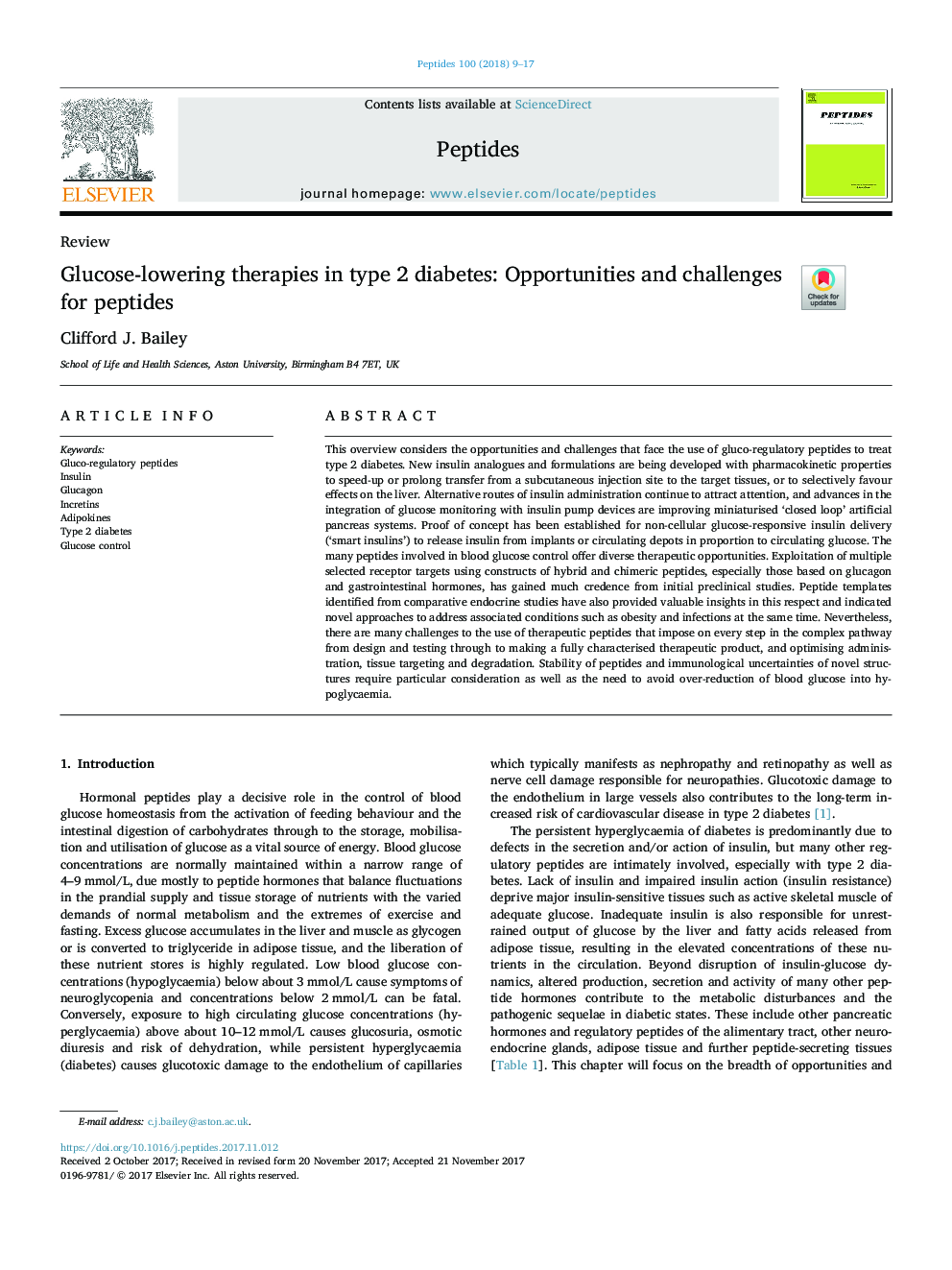| کد مقاله | کد نشریه | سال انتشار | مقاله انگلیسی | نسخه تمام متن |
|---|---|---|---|---|
| 8347431 | 1541679 | 2018 | 9 صفحه PDF | دانلود رایگان |
عنوان انگلیسی مقاله ISI
Glucose-lowering therapies in type 2 diabetes: Opportunities and challenges for peptides
ترجمه فارسی عنوان
درمان های کاهش دهنده گلوکز در دیابت نوع 2: فرصت ها و چالش های پپتیدهای
دانلود مقاله + سفارش ترجمه
دانلود مقاله ISI انگلیسی
رایگان برای ایرانیان
کلمات کلیدی
ترجمه چکیده
این مرور کلی از فرصت ها و چالش هایی است که با استفاده از پپتیدهای نظارتی گلوکز برای درمان دیابت نوع 2 مواجه است. آنالوگ های جدید انسولین و فرمولاسیون ها با خواص فارماکوکینتیک برای سرعت بخشیدن یا طولانی شدن انتقال از محل تزریق زیر جلدی به بافت هدف، و یا به طور انتخابی به اثرات بر روی کبد لطمه می زنند. راه های جایگزین تزریق انسولین همچنان به جذب توجه توجه می کنند و پیشرفت در ادغام نظارت بر گلوکز با دستگاه های پمپ انسولین، بهبود سیستم های لوزالمعده مصنوعی "پیچیده" مینیاتوری است. اثبات مفهوم برای تحویل انسولین واکنش گلوکز غیر سلولی ("انسولین هوشمند") برای تولید انسولین از ایمپلنت ها و یا انبارهای گردش خون به نسبت با گردش خون گلوکز است. پپتیدهای زیادی که در کنترل قند خون دخیل هستند، فرصت های مختلف درمان را ارائه می دهند. بهره برداری از اهداف گیرنده چند گانه با استفاده از ساختارهای پپتیدهای هیبرید و کیمری، به ویژه آنهایی که بر اساس گلوکاگون و هورمون های دستگاه گوارش است، از مطالعات پیشین اولیه پیشی گرفته است. الگوهای پپتیدهای شناسایی شده از مطالعات غدد درون ریز مقایسه ای نیز در این رابطه از دیدگاه ارزشمندی ارائه کرده اند و رویکردهای جدیدی را برای رفع مشکلات مربوط به چاقی و عفونت در همان زمان نشان داده اند. با این وجود، چالش های زیادی برای استفاده از پپتیدهای درمانی وجود دارد که بر روی هر مرحله از مسیر پیچیده از طراحی و آزمایش تا ایجاد یک محصول درمان شده به طور کامل مشخص شده و بهینه سازی مصرف، هدف گیری بافت و تخریب را تحمیل می کند. پایداری پپتیدها و عدم قطعیت ایمونولوژیک ساختارهای جدید نیازمند توجه خاص و همچنین نیاز به جلوگیری از کاهش قند خون به هیپوگلیسمی است.
موضوعات مرتبط
علوم زیستی و بیوفناوری
بیوشیمی، ژنتیک و زیست شناسی مولکولی
زیست شیمی
چکیده انگلیسی
This overview considers the opportunities and challenges that face the use of gluco-regulatory peptides to treat type 2 diabetes. New insulin analogues and formulations are being developed with pharmacokinetic properties to speed-up or prolong transfer from a subcutaneous injection site to the target tissues, or to selectively favour effects on the liver. Alternative routes of insulin administration continue to attract attention, and advances in the integration of glucose monitoring with insulin pump devices are improving miniaturised 'closed loop' artificial pancreas systems. Proof of concept has been established for non-cellular glucose-responsive insulin delivery ('smart insulins') to release insulin from implants or circulating depots in proportion to circulating glucose. The many peptides involved in blood glucose control offer diverse therapeutic opportunities. Exploitation of multiple selected receptor targets using constructs of hybrid and chimeric peptides, especially those based on glucagon and gastrointestinal hormones, has gained much credence from initial preclinical studies. Peptide templates identified from comparative endocrine studies have also provided valuable insights in this respect and indicated novel approaches to address associated conditions such as obesity and infections at the same time. Nevertheless, there are many challenges to the use of therapeutic peptides that impose on every step in the complex pathway from design and testing through to making a fully characterised therapeutic product, and optimising administration, tissue targeting and degradation. Stability of peptides and immunological uncertainties of novel structures require particular consideration as well as the need to avoid over-reduction of blood glucose into hypoglycaemia.
ناشر
Database: Elsevier - ScienceDirect (ساینس دایرکت)
Journal: Peptides - Volume 100, February 2018, Pages 9-17
Journal: Peptides - Volume 100, February 2018, Pages 9-17
نویسندگان
Clifford J. Bailey,
